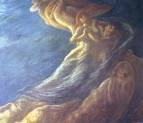Divisionism/Neo-Impressionism
dal 25/1/2007 al 14/4/2007
Segnalato da
Giovanni Segantini
Angelo Morbelli
Giuseppe Pellizza da Volpedo
Emilio Longoni
Gaetano Previati
Georges Seurat
Paul Signac
Camille Pissarro
Henri-Edmond Cross
Vivien Greene
25/1/2007
Divisionism/Neo-Impressionism
Guggenheim Museum, Berlin
Arcadia and Anarchy. The exhibition is dedicated specifically to the exploration of the optically vibrant paintings executed by the Italian Divisionists and their relationship to Neo-Impressionism. By placing the Italian movement in an international context the show will underscore the autonomy the Italians had from their European counterparts and their importance as pioneers of modernism. Approximately 40 paintings produced between the mid-1880s and the early 1900s. Curated by Vivien Greene.

Arcadia and Anarchy
curated by Vivien Greene
This exhibition is the first dedicated specifically to the exploration of the optically vibrant
paintings executed by the Italian Divisionists and their relationship to Neo-Impressionism. Like
the Neo-Impressionists, the Divisionists adopted a painting method rooted in color theory and
optics, frequently held left-wing political views, and depicted similar subject matter. These
shared concerns, paired with Divisionism’s emergence at a slightly later date than Neo-
Impressionism, have often caused the Italian style to be regarded merely as a derivation of the
French one. Yet distinct differences marked the Divisionist project, including a preference for
large-scale compositions, an ongoing interest in modeled form and the representation of threedimensional
space, and a desire to connote movement. The Italians eschewed representations
of bourgeois life or urban spectacle. Instead, they painted Symbolist imagery, largely absent
from the work of their European contemporaries. Underlining the paradoxical nature of Italian art
in this period, these pursuits both reflected the Divisionists’ grounding in the traditions of their
own long-standing artistic legacy and pointed the way for the next generation, the Futurists.
Taking such issues into account, Arcadia and Anarchy will reassess the prevailing perspective
on Divisionism. By placing the Italian movement in an international context the exhibition will
underscore the autonomy the Italians had from their European counterparts and their
importance as pioneers of modernism.
This focused exhibition of approximately 40 paintings will address images produced between
the mid-1880s and the early 1900s. The emphasis will be upon the major protagonists of Italian
Divisionism, among them Giovanni Segantini, Angelo Morbelli, Giuseppe Pellizza da Volpedo,
Emilio Longoni, and Gaetano Previati, whose works will be shown together with a selection of
paintings by artists such as Georges Seurat, Paul Signac, Camille Pissarro, and Henri-Edmond
Cross.
Image: Gaetano Previati
Press Contact: Sara Bernshausen
t. +49 30202093 sara.bernshausen@db.com
Press Conference: Friday, January 26, 11 a.m.
Deutsche Guggenheim
Unter den Linden 13-15, Entrance Charlottenstrasse - Berlin
Opening hours: Daily 11 a.m. to 8 p.m., Thursdays to 10 p.m.
Admission: 4 Euro, reduced 3 Euro- free entrance on Mondays



